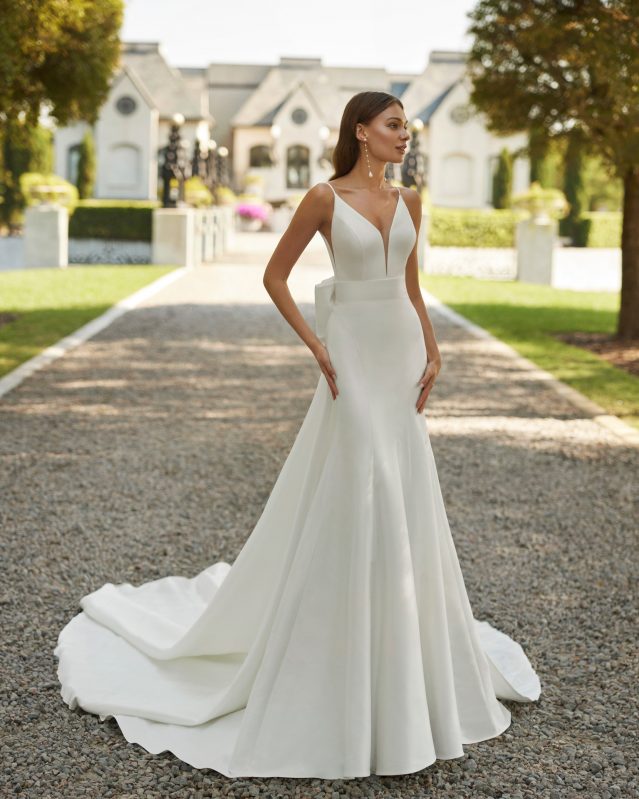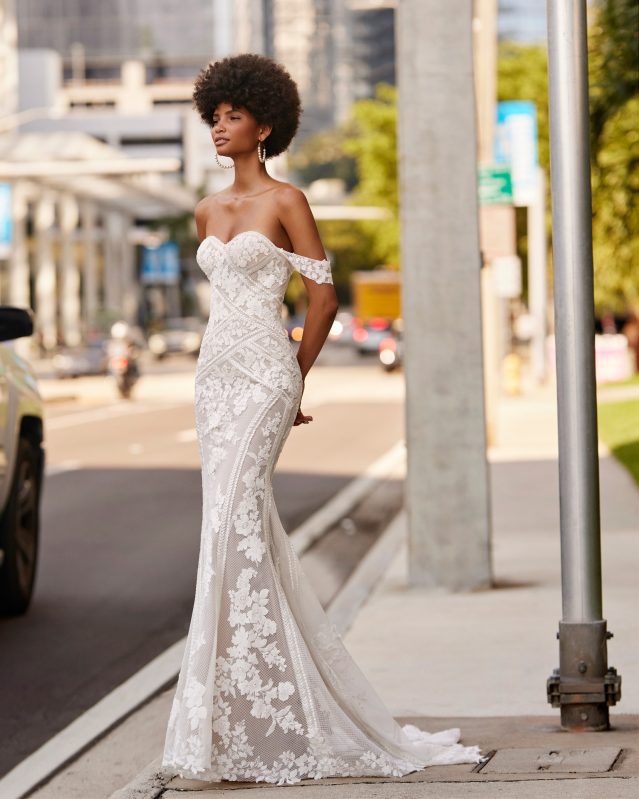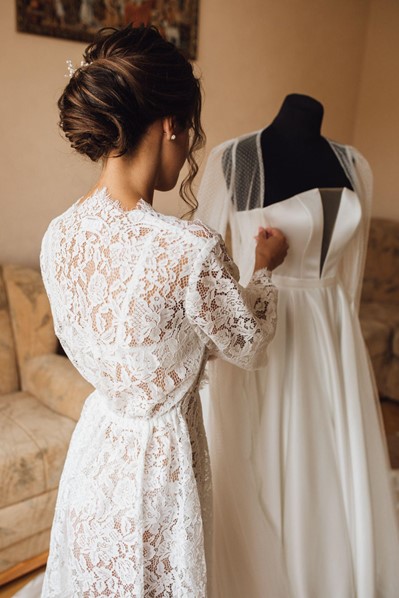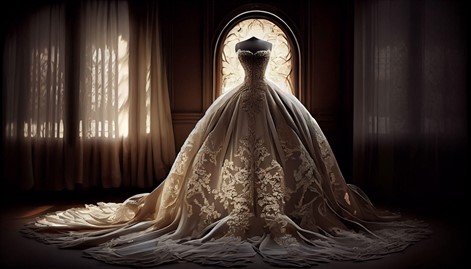Key Highlights
- Understanding the average wedding dress cost is crucial to budgeting effectively.
- The average cost of a wedding dress largely depends on location, designer, and materials used.
- Luxury and couture designers generally have higher prices, while more affordable options can be found at bridal shops.
- The fabric and detailing of a dress also affect its price, with luxurious embellishments costing more.
- Designer labels often have a higher price tag, but there are also off-the-rack options that offer good value for your money.
- Alterations and customisations are extra costs to budget for.
Introduction
You’ve found it – the wedding dress of your dreams. It’s a flowing ball gown silhouette with delicate off-shoulder cap sleeves and a full skirt adorned with shimmering tulle that sparkles like the stars.
Every inch of its bodice is detailed with pearls that catch the light in a mesmerizing dance. It’s just the perfect one – for you. But as you glance at the price tag, reality sets in. The wedding dress cost exceeds what you budgeted for your special day.
How do you avoid this? How do you budget effectively for your wedding dress without sacrificing the dress of your dreams? In fact, what’s the RIGHT budget for a wedding dress?
In this article, we’ll cover all these factors, uncover the hidden costs of alterations, appointments and customisations and provide tips on accessing your gown without overspending. Nazneen Sethna, Alter Me’s founder and creative director, also added a few insights based on her experience altering and designing wedding dresses.
Let’s jump right in!
Decoding Wedding Dress Costs
- Mermaid silhouettes
- Ballgowns (unless the bodice is very structured and balances the voluminous skirt)
When it comes to wedding dress costs, there is no one-size-fits-all answer. The average cost of a wedding dress can vary significantly depending on various factors.
For example, location plays a role, with urban areas typically having higher prices than rural ones. The designer label also impacts the cost, as luxury and couture brands have a higher price tag.
Understanding these factors can help you decode wedding dress costs and make an informed decision when budgeting for your dream gown.
Factors Influencing the Price of Your Dream Gown

In the previous section, we explored how the quality of fabric and designer labels influence wedding dress costs. In this section, we’ll uncover other factors that determine the cost of a wedding dress. Considering these factors can help you understand the price range of your dream gown and make a budget accordingly.
1. The Fabric
Wedding dress fabrics play a major role in influencing the cost of a wedding dress. Why should you pay attention to this? Your fabric choice can affect the silhouette and style of your wedding dress.
Nazneen affirms this: “Fabrics can play a huge part in the cost of a wedding dress. For example, satin fabrics can range in price from $20-$180+/m and lace fabrics from $50-$800/m. So if a dress takes 4m, making it out of plain fabric would be much cheaper than the same design being made in a lace fabric.”
When it comes to choosing fabrics for wedding dresses, you have three main options: synthetic, blended, and natural fabrics. Synthetic fabrics like polyester are affordable and easy to care for, making them a popular choice for budget-conscious brides.
Blended fabrics combine synthetic and natural fibers to offer a balance of affordability and quality. Rayon is a common blended fabric that mimics the drape and feel of natural fibers at a lower cost.
Natural fabrics, on the other hand, have a luxurious look and feel but often come with a higher price tag. Silk, satin, crepe, and lace are popular fabric choices for wedding dresses, and each comes with its own price range. Silk is known for its luxurious feel and high price point. It is a natural fabric made from silkworms’ fibers and requires a labor-intensive process to produce. Satin, on the other hand, is a smooth and glossy fabric that offers a similar lustrous appearance to silk but at a lower cost.
Tip: Consider your budget and the desired look and feel of your gown before choosing between any of these fabric options. Also, speak with a designer to help you make the right choice.
2. The Season
Wedding dress prices can also fluctuate based on seasonal demand. For example, during peak wedding seasons like summer and spring, the costs of a wedding gown may increase due to high demand.
Conversely, some bridal shops may offer discounts or promotions during slower seasons to attract customers. So, shopping for your gown during winter and spring is a perfect time to snag budget-friendly deals on your wedding dress.
Another possibility is the release seasons. Wedding gown designers release new collections periodically, often coinciding with the traditional fashion seasons as it is with clothing in any market. Dresses from these new collections are often expensive compared to those from previous seasons or on clearance. Nazneen goes further into this:
“If you purchase a wedding dress that has just been released in the new season’s collection, it will be more expensive than last season’s design. Previous gowns always get marked down and eventually end up selling at dirt cheap prices in sample sales.”
3. Your Accessories
While these are not directly tied to your wedding dress, they play an important role in accentuating the overall look of your wedding gown. For example, if you want a simple gown with minimal detailing, adding a dramatic veil or statement jewelry can elevate the simplicity of the dress. Nazneen said choosing accessories largely depend on your preferences and budget:
“Expensive accessories and jewelry can be enticing to wear on your special day, and most brides do. But I also know some brides that are on a budget will source cheaper accessories (such as imitations) and have the look but pay less.”
It’s also important to distinguish between essential pieces and optional splurges. Essential accessories like a veil or headpiece can highlight your bridal look and complete your ensemble. These items can range in price depending on their intricacy and materials used.
“The biggest selling bridal accessory is a veil.” Nazneen said. “We make custom veils in-house and offer a range of tulle fabrics and design options. We also make custom bridal, fingerless gloves.”
Optional splurges, on the other hand, are items that are not essential but can add a touch of luxury and personal style. This can include items like a tiara, statement jewelry, or pearls. While these splurges can enhance your look, they may not be necessary for every bride.
Tip: Consider your personal style and budget when deciding which accessories are worth the investment for your big day.
4. Your Budget
Your pre-set budget is also a guiding factor when choosing your wedding dress. Although some say it’s safer not to have a budget in place, we firmly believe it’ll help constrain your options.
Of course, a higher budget expands your options, including dresses from luxury designers or those made with high-quality fabrics. You can also choose to have a custom-made wedding dress.
Conversely, having a lower budget limits your options to more affordable designers, off-the-rack options, or second-hand wedding dresses. Setting a realistic budget can help narrow your choices and prevent overspending.
5. Alterations
If your gown isn’t custom-made, chances are high that you’ll have to alter the dress to your exact size. Almost every bride needs alterations to ensure the perfect fit and desired look.
Alterations can include taking in or letting out the seams, adjusting the hem, adding or removing sleeves, and more. As a result, the cost of alterations can vary depending on the complexity of the changes and the skill of the sewist.
In addition, customisations such as embellishments or changes to the design can add extra expenses. Understanding these hidden costs can help you budget effectively and avoid emergency expenses during the wedding process. Nazneen explains how the charges are at Alter Me:
“If a bride wishes to remodel her entire gown, such as remodel necklines, adding linings, remodelling the bottom half and top half of the dress, etc., it can cost over $1000.”
On average, wedding dress alterations costs can range from $300 to $900. Or more. Simple modifications like adjusting the hem or taking in the sides may cost around $100 to $400, while more intricate changes and customisations can increase the price.
In addition, Nazneen told us that the wedding dress fabric can affect alteration cost. In her words:
“Brides also need to take fabrics into account when getting alteration quotes. Lace/sequins/beaded fabrics will cost more than plain fabrics. Sewing machines can not sew on top of the beads so they either have to be crushed or unpicked prior to doing the alterations, and then hand sew them back on. Lace, if it’s overlapped (rather than sewn into the seams) it has to be unpicked, do the alteration, then overlap and hand sew the lace back on. Sequins are in the same scenario.”
6. Embellishments
Customising your wedding dress with personal touches and unique embellishments can make it memorable. However, this often comes with additional costs. Embellishments such as beading, lace appliqués, and embroidery require extra time and expertise, which can increase the price of the dress.
7. Designer

Designer wedding gowns have an undeniable allure. They are created by celebrity fashion designers who have mastered the art of bridal couture. These gowns are crafted with exceptional attention to detail, using luxurious fabrics and intricate embellishments. Renowned designers like Vera Wang and Stella York are known for their exquisite designs that showcase luxury and elegance. Be cautious, though. In this case, all that glitters isn’t always gold.
“Designers play a huge part in the overall cost of a wedding dress.” Nazneen told us. “The more established the designer is, the more popular or demand there is of them, which makes all brides want them, they will have a higher markup on their gowns. I’ve had many designer gowns come to us and sometimes it’s sad the quality we see inside the dress isn’t up to the “designer’s” standard. It’s often sad to know a bride doesn’t or won’t ever know this and they have paid an enormous price for it. I’m not saying all designer gowns are like this but you never know the quality of a dress until you open it up. “
At AlterMe, our goal is helping brides find high quality, luxury gowns for their big day. This is why we did the hard work to research and stock the highest quality labels, which includes designers Rosa Clara, Luna Novias & Adriana Alier. Check out some of our designs here.
8. Storage Options
When considering storage, prioritise preservation, protection, and accessibility. If the dress needs to be stored for an extended period, for example, such as months or years before the wedding, investing in proper storage becomes imperative.
If you opt for professional storage solutions, such as preservation boxes or garment bags specifically designed for wedding dresses, you’ll likely pay more. This is because these specialized storage options are engineered to shield the dress from light, moisture, and dust, therefore maintaining its pristine condition over time. While they may incur an initial expense, the long-term benefits of preserving the dress’s quality and integrity outweighs the cost.
On the other hand, choosing conventional storage methods, like using a regular garment bag or closet space, may seem cost-effective initially. However, these options may not provide adequate protection against environmental factors that could damage the dress. Exposure to sunlight, moisture, or pests could result in discolouration, fabric degradation, or even irreparable stains, are common issues you may experience, causing you to replace the entire wedding dress.
Read more: Storing your wedding dress at Alter Me.
Lastly, we have…
9. Location
The average cost of a wedding dress can also vary depending on the location and the designer. The average cost of a wedding dress ranges between $1800 – $8000 in the United States. However, this price does not include accessories or other wedding-related outfits.
A wedding dress in New Zealand falls within this price range too. Low quality or second-hand wedding dresses mostly fall below the $1000 mark.
Nazneen affirmed that a bespoke wedding dress in New Zealand ranges between $3500 – $7000, depending on the intricacy of the design and fabric used. Keep in mind that this price is likely different from other bridal designers.
What is the average cost of a wedding dress?
The average cost of a wedding dress can fall between $1800 to $8000. But it’s not uncommon to find dresses below or above this range. According to Nazneen, a designer gown can cost between $2500 – $8000. She also added:
“Second hand wedding dresses are usually sold for 50% of their purchase price. However, there are stores in New Zealand that cater to brides who want to pay less than $1000 for their gowns. But you will see the difference in quality. The average cost of a wedding dress in New Zealand is around $3000 – $7000 – though most brides won’t go beyond the $6000 mark.”
For instance, a dress with hand-sewn embellishments, intricate detailing and high-quality fabrics will cost more than a straightforward, machine-made gown. Also, second-hand dresses cost less than custom-made pieces. So it’s advisable to keep an open mind when exploring the options available to you.
What is the average cost of a wedding dress?

“Bridal alterations generally range between $300-$900.” Nazneen said. “This would include alterations such as shoulder lift, waist/hip take in and hemming. Please note this refers to plain dresses and some lace dresses that only involve one-two layers of fabrics. Every dress is different.”
Also, alteration costs may vary depending on the embellishments, detail, your preferences and how much work is involved. If you’re reconstructing the entire gown, adding extra detail to look more stylish, it’ll cost more than a simple hemming.
How much does it cost to make a custom wedding dress?
There’s no one-size-fits-all answer to this, as well. The cost of making a custom wedding dress varies, especially considering the above mentioned factors. Nazneen added some insights on this. She said:
“It depends on fabric cost and the intricacy of the design. For example, bridal fabrics can start from $30/m and can range to $800/m. This would change the price of the dress drastically. At Alter Me, we have a starting price of $2800 for simpler designs, mainly in plain fabrics, but most of our gowns range between $3500-$5500 (this includes plain fabrics as the designs are much more complex).”
Read more: The benefits of a custom wedding dress.
Do wedding dress appointments cost money?
There’s no perfect answer to this because it’s dependent on the bridal shop or designer you’re buying from. Some bridal shops charge a flat fee for appointments, while others waive it or include it in your final invoice so you don’t feel it’s a burden.
At Alter Me, for example, if you want to make an appointment for a bespoke wedding dress, we charge a flat fee that’ll be included in your budget if you decide to continue with us. A minimal fee helps us filter people with purchase intent from those looking to play dress up.
Nazneen agrees with this:
Additional styling tips: Do consider adding embellishments such as beading or crystals on your gown as these would draw attention to your gorgeous curves!
“Yes, we charge to make an appointment for a Bespoke wedding dress consultation. This allows a 1hr consultation where we can discuss with the client different silhouettes that would suit their body, look through any dresses they may have tried on and go through fabrics that would suit their dress design. The cost of this appointment comes off their overall invoice if they wish to proceed forward with the order.”
What if you just want to try on a wedding dress? Well, some bridal shops charge a one-time flat fee for brides looking for the right style for them, including Alter Me. Nazneen expounds that this cost is always weaved into the overall invoice once the customer makes an order:
“Yes, we charge for appointments to try on a wedding dress.” She said, “Each store has a different fee that can range from $40-$90+. This price includes a 1hr appointment to try on wedding gowns to know which style suits the bride the most. If the bride can’t decide on the day, some stores allow for them to come back without charging again. Again, this cost comes off the overall invoice if an order is placed.”
Let’s get to the exciting part…
How to Save Money on Acquiring a Wedding Dress
While you need to carefully choose the right dress for your special day, be careful not to bankrupt yourself. All that matters is what you want and how you’ll love to look on that day. It’s your day, remember?
Here’s what Nazneen has to say about saving money on a wedding dress:
“If you’re on a budget, try not to choose a lace, beaded or sequined wedding dress as when it comes to altering, that would be the most expensive aspect because the majority of the time, these dresses will need hand-sewing completed after the alterations are done.
Also, try to order the correct size so minimal alterations are required. If you can order a dress with the height measurement taken with the proper shoes/heels, the alterations cost will be less. Hemming is one of the most common alterations on a wedding dress.”
Here are some tips that help as well:
- Keep an eye out for sample sales, where bridal boutiques offer discounted prices on gowns that have been tried on but not purchased. These sales can provide significant savings.
- Consider shopping during seasonal discounts or promotional periods when bridal shops may offer special deals.
- Browse online retailers or consignment shops for discounted or second-hand wedding dresses.
- Shop during the off-season (typically winter and early spring) when demand is lower. You might snag a discount on a dress from the previous season’s collection.
- Consider pre-owned wedding dresses from online marketplaces or consignment shops. There are many beautiful, gently-used gowns available at a significant discount. Be sure to inspect the dress thoroughly and factor in potential cleaning costs.
- Order your gown at a trunk show, where you can find discounts or special promotions on dresses from the latest collections.
- When it comes to accessories, prioritize essential pieces that complement your gown, such as a veil or headpiece. These items can add a touch of elegance without emptying your wallet.
Conclusion
Budgeting for your dream wedding dress requires a thoughtful approach, considering materials, designer labels, alterations, and accessories. Understanding the cost components and setting a realistic budget can help you find value without compromising style.
Whether you opt for luxury or budget-friendly options, strategic shopping during sales and negotiating prices can make a significant difference. By planning and being mindful of hidden costs, you can confidently walk down the aisle in a gown that reflects your style while staying within your financial means.

